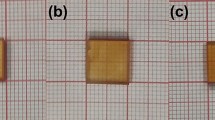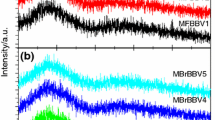Abstract
Glasses having composition 5Li2O–5ZnO– xBi2O3 –(90 − x) P2O5 (x = 5, 10, 15, 20 and 25 mol%) were prepared by the normal melt quenching technique. Nanocomposite glass containing bismuth phosphate BiPO4 nanocrystals was obtained, which can be attributed to homogeneous nucleation process. The formation of BiPO4 nanocrystals was confirmed and characterized by X-ray diffraction patterns (XRD), transmission electron microscopy (TEM), differential scanning calorimetry, optical absorption (UV–Vis) and micro-hardness studies. The morphological analysis by XRD and TEM microscopy showed the formation of hexagonal BiPO4 nanocrystals, and its estimated nanocrystalline sizes were found to be varying from 5.35 to 11.53 nm depending on the Bi2O3 concentrations. The density (ρ) and molar volume (V m) were also determined and found to be in compositional dependence. Glass transition temperature (T g) and glass crystallization temperature (T c) were obtained and found to be increased (from 240.0 to 337.2 °C) with increasing Bi2O3 up to 20 mol% and then decreased (from 337.2 to 331.8 °C) due to the structural changes in the glass network. Effect of BiPO4 content on the optical properties had been investigated. From the UV–Vis spectra, it was observed that the fundamental absorption edge shifts toward lower wavelengths, i.e., blueshifts with increasing Bi2O3 mol% up to 20 mol%, and then shifts toward higher wavelengths, i.e., redshifts beyond 20 mol%. It was also observed that the obtained E opt (for indirect and direct transitions) increases with gradual increase in Bi2O3 content up to 20 mol% and then decreases beyond 20 mol%. This may be due to the introduction of Bi cations into the glass network as a network former up to 20 mol% causing a decrease in ΔE values, beyond 20 mol%, the introduction of Bi ions into the glass network interstitially leads to increase the values of ΔE. The optical properties of the present nanocrystallized glasses showed a quantum size dependence, in which the optical band gap energy (E opt) was changed as a function of BiPO4 nanocrystalline sizes.













Similar content being viewed by others
References
Wilder JA. Glasses and glass ceramics for sealing to aluminum alloys. J Non Cryst Solids. 1980;38–39:879.
Proulx PP, Cormier G, Capobianco JA, Champagnon B, Bettinelli M. Raman and low-frequency Raman spectroscopy for barium, zinc and lead metaphosphate glasses doped with a trivalent europium ion. J Phys Condens Matter. 1994;6:275.
Campbell JH, Suratwala TJ. Nd-doped phosphate glasses for high-energy/high-peak-power lasers. J Non Cryst Solids. 2000;263–264:318.
Masingu A, Piccaluga G, Pinna G. Structural properties of lead-iron phosphate glasses by X-ray diffraction. J Non Cryst Solids. 1990;122:52.
Liu HS, Shih PY, Chin TS. Thermal, chemical and structural characteristics of erbium-doped sodium phosphate glasses. Phys Chem Glasses. 1996;37:227.
Sidek HAA, Hamezan M, Zaidan AW, Talib ZA, Kaida K. Optical characterization of lead-bismuth phosphate glasses. Am J Appl Sci. 2005;2(8):1266.
Chahine A, Et-Tabirou M. Structural study of (50-x) Na2O-xCuO-10 Bi2O3-40 P2O5 glasses Mater. Res Bull. 2002;37:1973.
Chahine A, Et-Tabirou M, Pascal JL. FTIR and Raman spectra of the Na2O–CuO–Bi2O3–P2O5 glasses. Mater Lett. 2004;58:2776.
Baia L, Stefan R, Popp J, Simon S, Kiefer W. Vibrational spectroscopy of highly iron doped B2 O3–Bi2 O3 glass systems. J Non Cryst Solids. 2003;324(1):109.
Borsa F, Torgeson DR, Martin SW, Patel HK. Relaxation and fluctuations in glassy fast-ion conductors: wide-frequency-range NMR and conductivity measurements. Phys Rev B. 1992;46:795.
Chang TS, Guijia L, Shin CH, Lee YK, Yun SS. Catalytic behavior of BiPO4 in the multicomponent bismuth phosphate system on the propylene ammoxidation. Catal Lett. 2000;68:229–34.
Kalaiselvan S, Jeevanram RK. A fast and simple method for the estimation of natural uranium in urine. J Radioanal Nucl Chem. 1999;240:277.
Högye Z. Separation of neptunium from urine by coprecipitation with BiPO4. J Radional Nucl Chem. 1998;227:127.
Litaka K, Tani Y, Umezawa Y. Orthophosphate ion-sensors based on a quartz-crystal microbalance coated with insoluble orthophosphate salts. Anal Chim Acta. 1997;338:77–87.
Alekseev VG, Gorelov IP, Kornilov MV. Membrane electrodes selective for hydrogen phosphate ions. J Anal Chem. 2000;55:1055–7.
Cho IS, Kim JR, Kim DW, Hong KS. Phase transformation and microwave dielectric properties of BiPO4 ceramics. J Electroceramics. 2006;16:379–83.
Pan C, Zhu Y. New type of BiPO4 oxy-acid salt photocatalyst with high photocatalytic activity on degradation of dye. J Environ Sci Technol. 2010;44:5570–4.
Romero B, Bruque S, Aranda MAG, Iglesias J. Syntheses, crystal structures, and characterization of bismuth phosphates. J Inorg Chem. 1994;33:1869–74.
Hongwei Huang, Chen Gong, Zhang Yihe. Two bi-based phosphate photocatalysts: crystal structure, optical property and photocatalytic activity. J Inorg Chem Commun. 2014;44:46–9.
Ambekar JD, Panmand RP, Sona Wane RS, Abte SK, Dilip G, Baharate B. Preparation of stable bismuth phosphate nanoparticles in phosphate glass and its magneto-optical study. J Name. 2013;1:1–3.
Chang Lang-Wei, Tsai Jui-Chien, Huang Tzu-Yun, Huang Chang-Wei, Lin Yang-Wei. Controlled synthesis, characterization and photocatalytic activity of BiPO4 nanostructures with different morphologies. J Mater Res Express. 2014;1:25023.
Taha TA, Azab AA. AC conductivity and dielectric properties of borotellurite glass. J Electron Mater. 2016;. doi:10.1007/s11664-016-4749-1.
Saddeek YB, Aly KA, Bashier S. Optical study of lead borosilicate glasses. Phys B. 2010;405(10):2407.
El-Joundi AS, Higazy AA. Elastic constants of zinc phosphate glasses containing europium. Indian J Phys. 1996;70A(4):517.
Brachkovskaya NB, Lunter SG, Przhevuskii AK, Raaben EL, Tolstoi MN. Effect of the number of 4f electrons on the intensities of optical transitions in the spectra of glass like metaphosphates of rare-earth elements and activated silicate glasses. J Opt Spectr. 1977;43(4):411.
Higazy AA, Ewaida ME, Hussein A, El-Bahnasawy R. The composition and electrical conductivity of bismuth phosphate glasses. Indian J Phys. 1989;63 A(2):124.
Xu S, Kang Z, Dai S, Wang G, Hu L, Jiang Z. Effect of Bi2O3 on spectroscopic properties of Er3+-doped lead oxyfluorosilicate glasses for broadband optical amplifiers. J Non Cryst Solids. 2004;347:197.
Losocka M. The effect of scanning rate on glass transition temperature of splat-cooled Te85Ge15. J Mater Sci Eng. 1976;23:173.
Kissinger HE. Reaction kinetics in differential thermal analysis. J Anal Chem. 1957;29:1702.
Nassau K, Chadwick DL. Glass-Forming Systems Involving GeO2 with Bi2O3, Ti2O, and PbO. J Am Ceram Soc. 1982;65(10):486.
Zheng H, Lin P, Xu R, Mackenzie J. Some optical properties of infrared transmitting Bi–Ca–Sr–Cu–O glasses. J Appl Phys. 1990;68:894.
Montagne L, Palavit G, Mairesse G, Draoui M, Aomari K, Saidildrissi M. The structural role of Bi3+ in Na2O–Al2O3–Bi2O3–P2O5 glasses. J Phys Chem Glasses. 1997;38:15.
Kishioka A. Glass formation in the Li2O–TiO2–P2O5, MgO–TiO2–P2O5 and CaO–TiO2–P2O5 Systems. J Bull Chem Soc Jpn. 1978;51(9):2559.
Guinier A. X-ray diffraction in crystals, imperfect crystals, and amorphous bodies. San Francisco: W. H. Freeman; 1963.
Mott NF, Davis EA. Electronic processes in non-crystalline materials. New York: Clarendon Press; 1979.
Urbach F. the long-wavelength edge of photographic sensitivity and of the electronic absorption of solids. Phys Rev. 1953;92:1324.
Stevels JM. Ultraviolet transmittivity of glasses. In: Proceedings 11th international congres pure and applied chemistry 1953; 5:519.
Khafagy AH, El-Adawy AA, Higazy AA, El-Rabaie S, Eid AS. Studies of some mechanical and optical properties of: (70 − x)TeO2 + 15B2O3 + 15P2O5 + xLi2O glasses. J Non-Cryst Solids. 2008;354:3152.
Author information
Authors and Affiliations
Corresponding author
Rights and permissions
About this article
Cite this article
Eltabey, M.M., Rady, K.E., Saad, S.A. et al. Synthesis and characterization of bismuth phosphate nanoparticle in glass matrix. J Therm Anal Calorim 128, 755–764 (2017). https://doi.org/10.1007/s10973-016-5978-5
Received:
Accepted:
Published:
Issue Date:
DOI: https://doi.org/10.1007/s10973-016-5978-5




